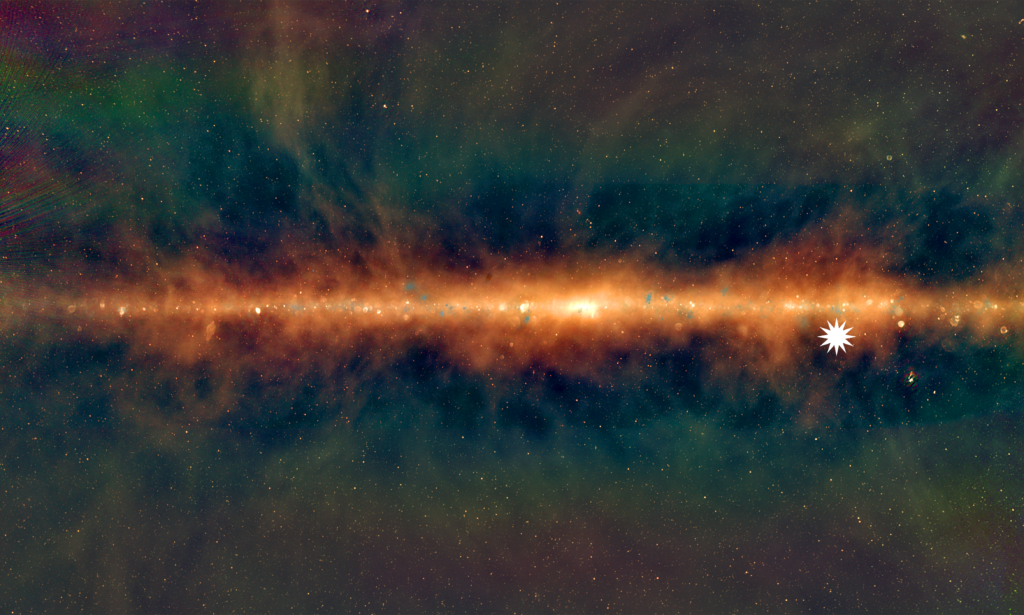Astronomers detect powerful cosmic object unlike anything they've seen before
It blinks too fast to be a supernova and too slow to be a pulsar. So what in the cosmos is it?

Astronomers have discovered a mysterious, flickering object in the Milky Way that belches enormous amounts of energy toward Earth three times an hour.
This strangely powerful object — located about 4,000 light-years from the sun — is unlike any cosmic structure ever observed, researchers wrote in a study published Jan. 26 in the journal Nature
The object in question — named GLEAM-X J162759.5-523504.3 (but let's call it GLEAM for short) — appeared out of nowhere on a recent radio wave survey of the Milky Way. According to the researchers, GLEAM brightened rapidly over the course of about 60 seconds, briefly becoming one of the brightest objects in the entire sky, then suddenly disappeared into darkness again. About 20 minutes later, the object reappeared — steadily glowing to peak brightness once again, before dimming back to nothing a minute later.
Objects like these, which appear and disappear before our telescope lenses, are known as transients. Typically, transients represent either a dying star (a supernova) or the bizarre, rapidly-spinning corpse of an already-dead star, also known as a neutron star. However, neither of those standard explanations quite fit with the behavior of this newfound object, researchers wrote in the new study.
It's possible that the mysterious GLEAM is evidence of a new type of stellar object that has only been theorized until now — or even one that astronomers haven't even dreamt up.
"This object was appearing and disappearing over a few hours during our observations. That was completely unexpected," lead study author Natasha Hurley-Walker, a radio astronomer at Curtin University in Bentley, Australia, said in a statement. "It was kind of spooky for an astronomer because there's nothing known in the sky that does that."
Related: 15 unforgettable images of stars
Get the world’s most fascinating discoveries delivered straight to your inbox.

Last light of a dying star
Transients typically come in two varieties. "Slow transients" can appear over the course of a few days, then disappear after several months. These include supernovas — which blaze brightly as dying stars shed their outer atmospheres in violent explosions, then gradually dim as the stellar leftovers drop in temperature.
Then, there are "fast transients," which flicker on and off every few milliseconds. These include objects like pulsars — neutron stars which rotate incredibly rapidly while flashing with bright radio emissions generated by the dead star's magnetic field.
The authors of the new study were looking for transients like these using the Murchison Widefield Array (MWA) radio telescope in the Australian outback, when they discovered GLEAM. The on-off blinking is too fast to be a supernova and too slow to be a pulsar; GLEAM's one-minute-long brightening pattern defies explanation, the researchers said.
An analysis of the object showed that it was incredibly bright but smaller than Earth's sun. GLEAM's radio emissions were also highly-polarized (that is, their light waves only vibrate on a single plane), suggesting they were generated by an extremely powerful magnetic field, according to the study authors.
These characteristics match a type of theoretical object known as an "ultra-long period magnetar," which is essentially a highly magnetized neutron star that rotates incredibly slowly. While predicted to exist, this rare class of object has never been observed in space before, the researchers said.
"Nobody expected to directly detect one like this because we didn't expect them to be so bright," Hurley-Walker said. "Somehow it's converting magnetic energy to radio waves much more effectively than anything we've seen before."
There may be other explanations for the mysterious GLEAM also, the researchers added. It could be a rare type of white dwarf star (the shriveled husk of a dead star that wasn't massive enough to collapse into a neutron star), which can very rarely emit radio emissions by sucking in material from a binary companion star. Such a star might appear to pulse like GLEAM, if it rotated at exactly the right speed, the team said.
Further observations in other bands of the electromagnetic spectrum are needed to solve this stellar mystery. Now that GLEAM has been detected, the researchers are also digging into archival observations from the MWA to see if any similar objects have ever turned up.
Originally published on Live Science.

Brandon is the space/physics editor at Live Science. His writing has appeared in The Washington Post, Reader's Digest, CBS.com, the Richard Dawkins Foundation website and other outlets. He holds a bachelor's degree in creative writing from the University of Arizona, with minors in journalism and media arts. He enjoys writing most about space, geoscience and the mysteries of the universe.
